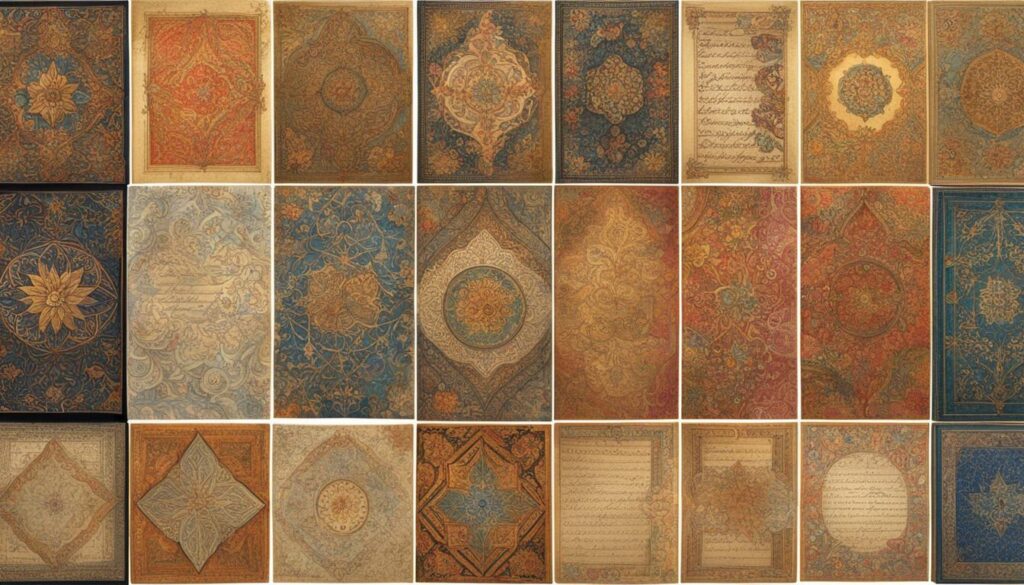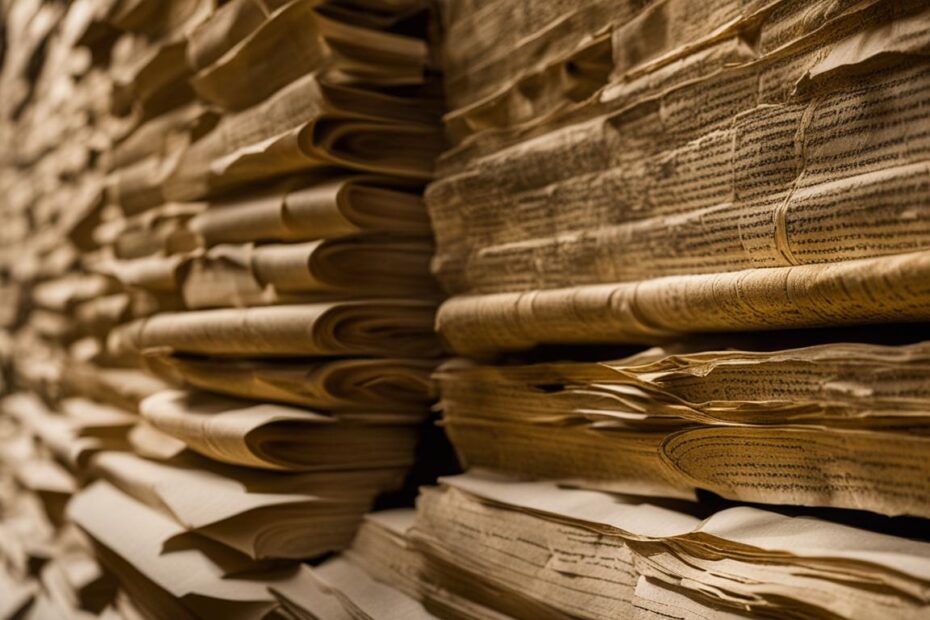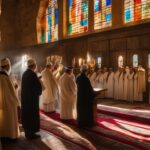Discover the centuries-old Jewish tradition of prayer notes, known as Kvittelach, and their profound significance in the spiritual lives of believers. Placing these handwritten prayers in the crevices of the Western Wall in Jerusalem is a practice that has endured the test of time, connecting individuals to their faith and the divine.
Throughout this article, we will explore how prayer notes are used in practice, their symbolic meaning, variations among different Jewish sects, the materials utilized, changes over time, and even some lesser-known tools used for this sacred act of devotion.
So, join us as we delve into the realm of prayer notes and uncover the profound tradition they embody.
Key Takeaways:
- Prayer notes, also known as Kvittelach, are a Jewish tradition that involves placing handwritten prayers in the cracks of the Western Wall in Jerusalem.
- These notes symbolize a deep connection to one’s faith and a tangible expression of one’s desires and hopes.
- While the practice of placing prayer notes is widely observed, there may be variations among different Jewish sects in terms of customs and beliefs.
- Prayer notes can be written on various materials, including colored paper, notebook paper, or even bubblegum wrappers.
- With the advent of technology, online services and digital platforms now allow individuals to send their prayers electronically.
How are Prayer Notes (Kvittelach) Used in Practice?
Prayer notes, also known as Kvittelach, serve as a means for individuals to express their deepest supplications and prayers to God. These devotional prayer notes can be written on various types of paper, including colored paper, notebook paper, or even bubblegum wrappers. The act of writing down these prayers allows individuals to articulate their innermost thoughts and connect with their faith on a personal level.
In today’s digital age, there are online platforms and prayer note apps that provide convenient ways to send prayer requests or notes to the Western Wall. These digital prayer notes allow individuals to submit their petitions via email, fax, text messaging, or the internet, ensuring that their prayers reach the sacred space of the Western Wall. Additionally, printable prayer notes provide a tangible option for those who prefer a more traditional approach.
Moreover, personalized prayer notes offer a unique way for individuals to infuse their distinct touch and intentions into their supplications. These personalized prayer notes may include additional elements such as artwork, illustrations, or specific formatting that reflect the individual’s personality and connection with their faith.
Table: Comparison of Different Methods for Sending Prayer Notes
| Method | Advantages | Disadvantages |
|---|---|---|
| Online Prayer Notes | Convenient and accessible from anywhere, ability to include personal messages | Lack of physical connection and tangible experience |
| Printable Prayer Notes | Provides a physical copy for personal keepsake, flexibility in customization | Requires access to a printer, may lack the immediate connection of digital submission |
| Personalized Prayer Notes | Allows for unique expression and personal touch, enhances emotional connection | May require additional artistic skills or resources, can be time-consuming |
“The act of writing down our prayers gives them a physical presence, a tangible form that helps us focus and find solace in our faith.” – Rabbi David Cohen
Overall, prayer notes, whether in their traditional or digital form, offer a way for individuals to intimately connect with their spirituality and express their deepest desires to God. It is a practice that transcends boundaries and sects, allowing people from all walks of life to find solace and hope in their prayers.
What do Prayer Notes (Kvittelach) Symbolize?
Prayer notes, also known as Kvittelach, hold deep symbolism in various religious and spiritual traditions. These notes represent a tangible connection between the individual and their faith, serving as a means of expressing their deepest desires, hopes, and faith in divine intervention.
The act of writing down these prayers and placing them in a sacred space, such as the Western Wall, carries profound spiritual significance. It signifies a belief in the power of prayer and a desire for a direct connection with the divine. The prayer notes themselves are considered sacred and are treated with utmost reverence and respect.
Just as the written prayers are a symbolic representation of the individual’s spiritual yearnings, the act of placing them in a sacred space symbolizes the act of surrendering these desires to a higher power. It is a way of entrusting one’s hopes and aspirations to the divine and seeking guidance, solace, and blessings.
The Symbolism of Prayer Notes
When individuals write their prayers on paper and place them in sacred spaces, they are symbolically offering their deepest concerns and desires to a higher power. The written words become a physical representation of their intentions and a reminder of their faith and connection to the divine.
Prayer is not asking. It is a longing of the soul. It is daily admission of one’s weakness. It is better in prayer to have a heart without words than words without a heart. – Mahatma Gandhi
The act of placing prayer notes in a sacred space also serves as a visual representation of unity and collective prayer. It demonstrates that individuals from various walks of life, with different concerns and hopes, are bound by a shared belief in the power of prayer and the interconnectedness of humanity.
The symbolism of prayer notes is deeply personal and can vary from individual to individual. For some, it represents an act of humility, acknowledging their dependence on a higher power. For others, it is an expression of gratitude and thanksgiving. In essence, prayer notes symbolize the human desire for connection, guidance, and a deeper understanding of the divine.
Are there Variations Among Sects?
While the practice of placing prayer notes in the Western Wall is widely observed among Jews, there may be variations in how different sects approach this tradition. Different Jewish sects may have their own specific guidelines or customs when it comes to writing and placing prayer notes, reflecting their unique beliefs and interpretations of Jewish law. These variations highlight the diversity within the Jewish community and the different ways in which individuals connect with their faith.
For example, some sects may have specific rules regarding the language in which the prayer notes should be written. Certain sects may require the prayer notes to be written exclusively in Hebrew, the sacred language of Judaism, while others may allow prayers to be written in other languages as well. Additionally, some sects may emphasize the importance of personalizing the prayer notes, while others may prioritize the content of the prayers themselves.
Despite these differences, it is important to note that the act of placing prayer notes in the Western Wall is a unifying practice among all Jewish sects. It serves as a physical representation of the individual’s connection to their faith and their desire for divine intervention. The Western Wall, often referred to as the Wailing Wall, holds deep spiritual significance for Jews from various sects, and the act of placing prayer notes transcends any sectarian boundaries.

| Sects | Variations in Prayer Note Practices |
|---|---|
| Orthodox Judaism | Emphasizes strict adherence to Jewish law and may have specific guidelines for the format and content of prayer notes. |
| Conservative Judaism | Tends to be more flexible in their prayer note practices, allowing for a wider range of languages and personalization. |
| Reform Judaism | Focuses on individual interpretation and personal connection with the divine, allowing for greater variation in prayer note practices. |
These are just a few examples of the many sects within Judaism and the potential variations in their prayer note practices. Each sect brings its own unique perspective and traditions to this ancient and revered tradition, further enriching the tapestry of Jewish prayer.
Materials Used for Prayer Notes (Kvittelach)
Prayer notes, also known as Kvittelach, can be written on a wide variety of materials, allowing individuals to personalize their prayers and make them more meaningful. Commonly used materials for prayer notes include:
- Colored paper: Many people choose colored paper to add vibrancy and visual appeal to their prayer notes.
- Notebook paper: Plain notebook paper is often used for its simplicity and ease of writing.
- Bubblegum wrappers: Surprisingly, some individuals repurpose bubblegum wrappers to write their prayers, giving a unique touch to their notes.
- Special paper or stationery: Some people opt for special paper or stationery to make their prayer notes feel more significant and sacred.
The choice of material for prayer notes varies depending on personal preference and availability. Whether it’s colorful paper, traditional notebook paper, or even an unconventional choice like bubblegum wrappers, what truly matters is the intention and sincerity behind the prayer, rather than the specific material used.
“It is not the pen and paper that make a prayer note sacred. Rather, it is the heartfelt words and intentions behind it that hold true significance.” – Rabbi David Cohen
As Rabbi David Cohen beautifully puts it, the material used is not what makes a prayer note sacred. Instead, it is the emotions, hopes, and faith that the note carries, regardless of the medium.
Table: Materials for Prayer Notes (Kvittelach)
| Material | Description |
|---|---|
| Colored paper | Used to add vibrancy and visual appeal to prayer notes. |
| Notebook paper | Plain paper commonly used for its simplicity and ease of writing. |
| Bubblegum wrappers | Unconventional choice for writing prayers, giving a unique touch to the notes. |
| Special paper or stationery | Opted for by some individuals to make prayer notes feel more significant and sacred. |
How have Prayer Notes (Kvittelach) Changed Over Time?
The practice of placing prayer notes in the Western Wall has evolved over time. From its humble beginnings in the 18th century to the present day, this tradition has witnessed significant changes in how people engage with it. In the past, individuals would write their prayers on slips of paper and physically insert them into the cracks of the wall. However, with the advent of technology, new methods of sending prayer notes to the Western Wall have emerged.
Today, the digital age has made it possible for people to submit their prayer notes electronically. Online platforms allow individuals from around the world to send their supplications via email, fax, text messaging, or the internet. This evolution has made the practice more accessible and convenient, especially for those who cannot physically visit the Western Wall. Despite these changes, the core essence of the tradition remains intact – the act of expressing one’s deepest prayers and hopes.
To visually represent the evolution of prayer notes, we have created a table showcasing the changes in practice over time:
| Era | Method of Sending Prayer Notes | Advantages | Disadvantages |
|---|---|---|---|
| 18th Century | Physical insertion into the cracks of the wall | – Direct connection to the sacred site – Tangible expression of faith |
– Limited accessibility – Prone to damage or loss |
| 20th Century | Mail or delivery services | – Ability to send from afar – Increased convenience |
– Still limited by physical distance – Delivery time |
| 21st Century | Online submission via email, fax, text, or internet | – Global access – Instantaneous submission – No physical limitations |
– Lack of physical connection – Potential for impersonalization |
It is important to note that despite these changes in the means of submission, the spiritual significance and intention behind the prayer notes remain at the heart of the tradition.

Unique and Unconventional Tools for Prayer Notes (Kvittelach)
While the practice of placing prayer notes in the Western Wall is the most well-known and widely observed, there are also unique and lesser-known tools used by individuals to express their prayers in creative ways. These unconventional practices offer a different approach to connecting with the divine and communicating heartfelt supplications. Here are some examples of these lesser-known tools:
Prayer Ribbons
Some individuals prefer to write their prayers on small pieces of fabric or ribbons and then tie them to the Western Wall. The colorful ribbons fluttering in the breeze signify the prayers floating up to the divine realm. This practice adds a visual element to the act of prayer, making it a tangible and symbolic expression of one’s deepest desires.
Artistic Prayer Notes
For those who have a creative inclination, art can be a powerful medium for expressing prayers. Instead of writing their prayers on paper, some individuals create personalized art or illustrations representing their hopes and desires. These unique artworks are then placed in the cracks of the Western Wall, infusing the act of prayer with artistic expression.
Prayer Tokens
Another unconventional tool for prayer notes is the use of prayer tokens. These small objects, such as stones, coins, or trinkets, are imbued with personal meaning and significance. Individuals may write their prayers on these tokens or attach small notes to them before placing them in the Western Wall. This practice allows for a physical representation of one’s prayers and a tangible connection to the sacred space.

These unique and lesser-known tools for prayer notes offer individuals a way to express their devotion and communicate with the divine in a more personalized and creative manner. While the act of placing notes in the Western Wall remains the central practice, these unconventional methods add depth and symbolism to the tradition of Kvittelach.
The Spiritual Significance of Placing Notes in the Western Wall
The act of placing prayer notes in the Western Wall is deeply rooted in Jewish spirituality. It is believed that the Divine Presence rests upon the Western Wall, making it a sacred space for communication with God. According to Midrashic and Kabbalistic teachings, all prayers ascend to Heaven through the Temple Mount, which the Western Wall abuts. Placing prayer notes in the wall is seen as a way to connect with the divine and have one’s prayers heard.
“The Western Wall is a conduit for our deepest spiritual expressions. When we place our prayer notes within its cracks, we are tapping into a sacred connection with the Divine Presence. It is a tangible way for us to voice our hopes, desires, and faith in God’s intervention, knowing that our prayers are being heard,” explains Rabbi Samuel Cohen, a prominent religious scholar.
The act of placing prayer notes in the Western Wall symbolizes an individual’s profound connection to their faith. By physically inserting these notes into the cracks of the wall, individuals demonstrate their belief in the power of prayer and their desire for divine intervention. The notes themselves are considered sacred and are treated with utmost reverence and respect.
Placing prayer notes in the Western Wall is a deeply personal and meaningful practice that transcends sects within Judaism. Whether written on colored paper, notebook paper, or even bubblegum wrappers, these notes represent a heartfelt expression of one’s deepest desires and hopes. The act of placing them in the Western Wall signifies a universal belief in the power of prayer and the desire to establish a connection with the Divine.
The Spiritual Significance of Placing Notes in the Western Wall
| Symbolism | Materials | Variations among Sects | Unconventional Tools |
|---|---|---|---|
| Deep connection to faith | Colored paper, notebook paper, bubblegum wrappers | Minor variations in customs | Small pieces of fabric, personalized art |
| Belief in the power of prayer | Special paper or stationery | Different beliefs about efficacy | Illustrations representing prayers |
Overall, the spiritual significance of placing prayer notes in the Western Wall is a powerful testament to the unwavering faith and connection of individuals with their divine beliefs. It is a practice that brings people of different sects together, uniting them in their shared pursuit of a connection with the Divine Presence.
Conclusion
Prayer notes, also known as Kvittelach, have a rich history and spiritual significance in Jewish tradition. The act of placing these notes in the Western Wall is a deeply personal and meaningful practice for individuals seeking divine intervention and connection with God.
While there may be variations in how different sects approach this tradition, the core essence remains the same – the expression of heartfelt prayers and hopes. The evolving nature of this tradition, including the use of digital platforms, has made it more accessible to people worldwide.
The practice of placing prayer notes in the Western Wall continues to be a powerful way for individuals to communicate their deepest desires and hopes to God. It symbolizes a deep connection between the individual and their faith, representing a tangible expression of one’s deepest desires, hopes, and faith in God’s intervention. As the tradition of Kvittelach continues to evolve, the power of prayer remains at its heart, providing solace, hope, and a sense of unity among believers.
FAQ
What is the tradition of placing prayer notes in the Western Wall?
Placing prayer notes in the Western Wall is a Jewish tradition that dates back to the 18th century. It involves inserting slips of paper containing written prayers into the cracks of the Western Wall in Jerusalem.
How are prayer notes (Kvittelach) used in practice?
Prayer notes, also known as Kvittelach, are used by individuals to communicate their heartfelt supplications and prayers to God. They can be written on various types of paper and even sent electronically through online services or prayer note apps.
What do prayer notes (Kvittelach) symbolize?
Prayer notes symbolize a deep connection between the individual and their faith. They represent a tangible expression of one’s deepest desires, hopes, and faith in God’s intervention.
Are there variations among sects in the use of prayer notes (Kvittelach)?
Yes, there may be variations in how different sects approach the tradition of placing prayer notes. Some sects may follow specific guidelines or customs, while others may have different beliefs about the efficacy of this practice.
What materials are used for prayer notes (Kvittelach)?
Prayer notes can be written on various materials, including colored paper, notebook paper, and even bubblegum wrappers. The choice of material often depends on personal preference and availability.
How have prayer notes (Kvittelach) changed over time?
The practice of placing prayer notes in the Western Wall has evolved with technology. Today, there are online services that allow individuals to send their prayer notes electronically. However, the core essence of the tradition remains the same – the expression of heartfelt prayers and hopes.
Are there unique, lesser-known tools for prayer notes (Kvittelach)?
Yes, some individuals may choose to write their prayers on small pieces of fabric or tie them to the Western Wall. Others may create personalized art or illustrations representing their prayers and place them in the cracks of the wall.
What is the spiritual significance of placing prayer notes in the Western Wall?
Placing prayer notes in the Western Wall is believed to be a way to connect with the divine and have one’s prayers heard. It is seen as a sacred space for communication with God.








